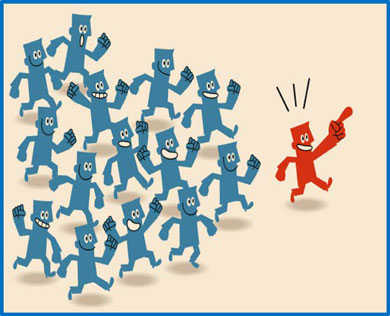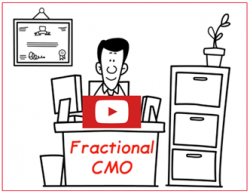In this issue:

Tips for Getting More Out of Your Trade Show
Fall is a season everyone likes for all kinds of reasons… the weather is more comfortable, leaves are changing, and the holidays are right around the corner. Fall is exciting because it is also trade show season! Countless businesses will be showing off their products and services in trade shows and conferences to potential buyers.
Indeed, tradeshows are a great opportunity to get in front of many interested and potential buyers in one place, and in a short period of time. Other than tradeshows, opportunities for such concentrated and focused marketing and sales efforts are few and far between
There are several marketing tools to help you accomplish these goals. However, in this particular newsletter, we will focus on… newsletters!
Some years ago, I worked with a business owner who told me “trade shows are just an excuse for marketing and sales people to drink expensive wine and eat $40 steaks”. He also said that trade shows were a waste of money because nothing beneficial to his business came out of them.
Tradeshows can be expensive, and they can be a waste of time and other resources. However, they can also be extremely beneficial. Here are a few tips you might not have considered to get more out of your trade show:
- Consider each trade show to be part of your overall marketing strategy not a singular isolated event, and build an entire marketing campaign around it
- Reach out to attendees well in advance of the show (most trade shows will share lists of attendees who registered and/or previous years’ lists) and invite them to visit your booth
- In the invitation, offer attendees an incentive to come and visit your booth (“Show us this email on your smart phone and receive a free…”)
- In most cases, it is more beneficial to have sales staff in the booth, as opposed to marketing – This will eliminate the extra step of handing over leads to sales and will provide the prospect with a more direct and streamlined follow-up
- While at the show continue to communicate with attendees via email, text messages, and social media – invite them to demos and other activities that you do
- Consider an after-hours hospitality suite, a golf tournament, or other outing event for your prospects and clients who attend the show, and invite them well in advance
- If possible, build up the anticipation through communication prior to the show, and release or announce a new product during the show for maximum exposure
- Make your booth exciting, intriguing, and interesting – you only have a few precious seconds to grab attendees’ attention while they walk the aisles
- Stand, don’t sit in your booth, and never position yourself behind a table
- Politely, creatively, and respectfully engage people who walk by your booth and invite them in
- Talking to people for hours can dry your mouth… have some mints and water handy
- Arrange your booth as a space attendees can walk into and away from the crowds in the aisles – don’t carry on long conversations or demonstrate your product in the aisle
- Collect contact information from those who visit your booth and their particular interest and do it using electronic devices (barcode scanners, business card scanners, smartphone scanners, etc.)
- Always follow up with attendees after the show, especially ones who stopped at your booth and showed interest in your offering
- In your follow up, consider offering a trade show-attendees ‘special’ to help close the deal
Getting more out of your trade show takes planning and effort before, during, and after the show, but all this hard work can pay big dividends!
If you need our help, Fractional CMO is always here to answer questions and help you with anything marketing-related.

Duke Merhavy, MBA, Ph.D.
President & Chief Marketing Officer
Marketing Lingo: “Buyers’ Journey”
The buyer’s journey is the process a typical buyer goes through starting when the need arises, and goes through the buyer’s experience with the product after the purchase.
Generally speaking, all purchasing decisions go through the six steps listed below:
- Unawareness
- Realization of problem or need
- Information gathering
- Evaluation of options
- Decision making
- Experience
It is important to mention that sometimes buyers go through these steps very quickly, as the case might be with impulse purchases, yet sometimes, the process spreads over a long period of time when they deal with high-ticket items, for example.
Our marketing activities, the platforms we use, and our messaging must fit and address the particular stage the prospect we are targeting might be in. Proper marketing and sales efforts will attempt to identify at what stage of the journey he or she is at, and then usher them through the process by providing them with what they need, in the way they prefer to receive it.
‘Marketing Lingo’ is a regular column in which we define, or otherwise explain, terms often used in marketing but not necessarily correctly or properly by some
Common Small Businesses Approaches to Marketing Leadership
Small businesses often evolve and grow organically, as opposed to starting up with a detailed plan that is well funded in advance. In these types of businesses and under these circumstances, who provides marketing leadership?
Here are the four typical approaches most often pursued:
 Two years ago, we developed a model to provide small businesses with cost-effective marketing leadership that was not available before. This Fractional CMO (Chief Marketing Officer) model provides small businesses with the expertise of a seasoned small business marketing executive for a fraction of the cost it would be otherwise. In fact, the cost of engaging a Fractional CMO is even less than the cost of employing a recent college graduate with minimum experience.The owner or another key person on the staff takes responsibility for marketing. This approach seems great because it requires no additional expenditures, especially in the short-run. Unfortunately, however, the owner or the other person handling marketing does so as an added responsibility to their “regular” job and title. The end-result is that their “real” job responsibilities suffer or, more often than not, marketing responsibilities are pushed aside… sometimes, indefinitely.
Two years ago, we developed a model to provide small businesses with cost-effective marketing leadership that was not available before. This Fractional CMO (Chief Marketing Officer) model provides small businesses with the expertise of a seasoned small business marketing executive for a fraction of the cost it would be otherwise. In fact, the cost of engaging a Fractional CMO is even less than the cost of employing a recent college graduate with minimum experience.The owner or another key person on the staff takes responsibility for marketing. This approach seems great because it requires no additional expenditures, especially in the short-run. Unfortunately, however, the owner or the other person handling marketing does so as an added responsibility to their “regular” job and title. The end-result is that their “real” job responsibilities suffer or, more often than not, marketing responsibilities are pushed aside… sometimes, indefinitely.- Some lucky small businesses have the resources to hire an employee for the marketing role. This is good because it gives the company complete control of a dedicated resource to manage marketing. Over the years, the marketing discipline has developed and become more sophisticate, and the number of marketing tools available multiplied. Providing strategic marketing leadership even to small companies required the level of expertise and knowledge that is too expensive for most small businesses to justify or afford. Consequently, these businesses hire whom they can afford as opposed to whom they need. This approach often ends with big disappointment, frustration, and wasted resources.
- To solve the problem of needing high level of expertise not available within the company, some small businesses turn to advertising agencies or digital marketing agencies to provide overall marketing direction and guidance. Agencies are very good at what they do and many deliver results. What many small businesses realize over time is that the great majority of agencies specialize only in certain marketing disciplines, and therefore tend to gravitate to using their tools mostly (if not exclusively). In other words, advertising agencies will frequently attempt to solve every problem by doing more advertising or varying media and will be less likely to consider other aspects of marketing.
- Sadly, some owners of small businesses who understand the shortcomings of the common approaches mentioned above just gave up on marketing all together. They concluded that since they cannot afford to hire the person who would be able to chart a strategic marketing approach and lead them through implementation, there is no point in squandering time and money on half measures.
The model is very straight forward: Instead of hiring a senior-level marketing expert to lead your marketing efforts, you engage a Fractional CMO as an outsource on a part-time basis for a fraction of the cost.
If you want to learn more about how the Fractional CMO concept works, watch this short explainer video; and if you are interested in learning about being a Fractional CMO click here or give us a call at 888-412-2236.
What Is Fractional CMO?
Hiring a full-time CMO (Chief Marketing Officer) is often not cost-effective for most small-to-mid-sized businesses (SMBs). We offer SMBs senior-level expertise, experience, and a holistic marketing approach, on a part-time basis for a fraction of the cost.
Fractional CMO is dedicated to your success, and our mission is to turn your vision into reality. Click on the short explainer video to the right for a quick explanation.
Take Advantage of Us
Give us a call at 888-412-2236 or click on the button below to request a complimentary Marketing Needs Assessment, or to ask us a question regarding your most pressing marketing or sales challenges.

